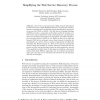Free Online Productivity Tools
i2Speak
i2Symbol
i2OCR
iTex2Img
iWeb2Print
iWeb2Shot
i2Type
iPdf2Split
iPdf2Merge
i2Bopomofo
i2Arabic
i2Style
i2Image
i2PDF
iLatex2Rtf
Sci2ools
ESWS
2008
Springer
2008
Springer
Simplifying the Web Service Discovery Process
One of the crucial reasons for adding semantic descriptions to Web services is to enable intelligent discovery, removing the need for a human to manually search and browse textual descriptions in repositories of services, like UDDI or ebXML. The Web Service Modeling Ontology (WSMO) provides a conceptual model within which the function of a Web service can be described in terms of formalized pre- and postconditions over the information space and assumptions and effects related to the real world; however WSMO is very flexible in the way in which the Semantic Web Service developer can use these elements to describe the functionality of a service. Thus a number of approaches for effectively describing the offered function of a Web service and the requirements of users, along with methods to compare them have surfaced in the last number of years, leaving developers unsure of which approach to use and if it is possible to combine them. In this paper we introduce a framework within which thes...
| Added | 19 Oct 2010 |
| Updated | 19 Oct 2010 |
| Type | Conference |
| Year | 2008 |
| Where | ESWS |
| Authors | Nathalie Steinmetz, Mick Kerrigan, Holger Lausen, Martin Tanler, Adina Sirbu |
Comments (0)

